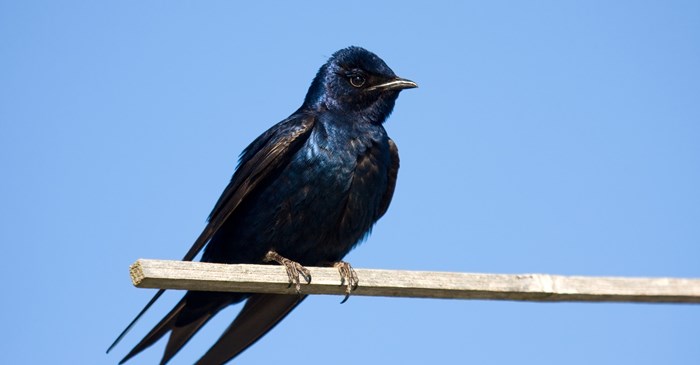The Purple Martin has a special place in the heart of American bird lovers. The best way to observe these fascinating inky blue-feathered birds is to set up a martin house in your yard in the early spring.
Habitat & Behavior
Purple Martins are known to nest in colonies. In the eastern U.S. Purple Martins can be found, almost exclusively, nesting in people-provided martin housing. They’ll take to “martin condos,” which are species-specific bird houses made with wood or aluminum containing eight to 12 “rooms” or nesting compartments. For a more traditional birdhouse you can secure hollowed-out gourds to a tree or high structure like the Native Americans did before Europeans came to America.
Older martins will return to the same nesting sites year after year. These older males are the first arrivals of spring before they’re joined by younger adults. While it might appear these “early birds” are “scouts”, they don’t actually return to guide other birds to the nesting site.
Even when nesting in close quarters Martins defend their "territories." By the time the eggs are laid, males and females will defend the individual compartment holding their nest. If a bird enters another bird’s compartment, a fight may break out.
Purple Martins feed on insects, and although they may nest in your martin house, they will not be interested in your backyard feeder. Instead, you’ll find them flying high in the sky, 150 feet up or more, gliding and circling to catch flying insects.
Migration
Purple Martins prepare to migrate as early as July, after their brood of nestlings fledge. They’ll gather up into roosts numbering hundreds or thousands of birds to prepare to migrate to South America. These migration roosts can be found high in the treetops and near bodies of water, such as lakes and rivers.
Population in Decline
While not endangered, since the 1960s, Purple Martin populations have steadily decreased, thanks in part to competition from the European Starling and the House Sparrow, both of which are non-native species to North America. These birds will invade even an established Martin nesting site. However, many people have had success in keeping the starlings out by changing the entrance holes to oblong and other shapes. Otherwise, if these birds “move in," simply pull out the nesting material and they’ll eventually move on.
Setting up a bird feeder in your yard is a great way to see wild birds up close. However, not all birds are interested in seeds and nuts. Providing water and nesting boxes is a great way to see more varieties of bird species in your region, like the Purple Martin.
